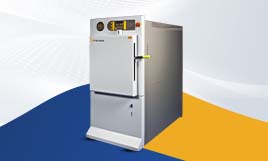The Advantages of Using a Vacuum Chamber Furnace for Sintering Processes
Sintering is a process used to create solid materials from powders. In this process, the powders are heated to a temperature below their melting point, causing them to fuse together.
This process is used in industries where high-quality, high-strength materials are needed, and where traditional manufacturing techniques such as casting or forging are not practical or cost-effective. Sintering provides a way to produce parts with complex shapes, high precision, and excellent mechanical properties.
One way to improve the quality and consistency of sintered materials is to use a vacuum chamber furnace. In this blog post, we will discuss the advantages of using a vacuum chamber furnace for sintering processes.
Reduced Oxidation
When materials are heated in the presence of oxygen, they can react with the oxygen to form oxides. These oxides can change the properties of the sintered material and affect its strength and performance.
Performing the sintering process in a vacuum chamber furnace results in minimised oxidation. Therefore, producing higher-quality sintered materials.
Precise Control of Sintering Atmosphere
A vacuum environment allows for precise control of the sintering atmosphere. In a vacuum chamber furnace, the level of gas and pressure can be controlled, allowing for a specific atmosphere to be created.
This atmosphere can be tailored to the specific materials being sintered, optimising the sintering process for the best possible results. At BCL, we offer metallic Vacuum Chamber Furnaces manufactured by Carbolite Gero, which provide a precisely controlled atmosphere of the highest possible purity (6 N or better).
Higher Sintering Temperatures
In a vacuum environment, materials can be heated to higher temperatures without the risk of oxidation or other chemical reactions that can occur in air. This allows for the creation of materials with higher melting points or greater strength.
The vacuum chamber furnaces in our stock - the HTK W offers maximum temperature for 2200 °C and 1600 °C. But that’s not all, to improve temperature uniformity, experts can also use a retort.
Faster Sintering Times
Using a vacuum chamber furnace can result in faster sintering times. With precise control of the sintering atmosphere and the ability to reach higher temperatures, sintering times can be reduced. This means that materials can be produced faster, resulting in increased productivity and lower costs.
Conclusion
Using a vacuum chamber furnace for sintering processes provides many advantages. By removing the air from the furnace chamber, oxidation is minimised, resulting in higher-quality sintered materials.
Precise control of the sintering atmosphere allows for tailored environments to be created, optimising the sintering process. Higher sintering temperatures can be reached, allowing for the creation of materials with greater strength or higher melting points.
Finally, using a vacuum chamber furnace can result in faster sintering times, increasing productivity and reducing costs. If you are involved in sintering processes, consider using a vacuum chamber furnace to achieve the best possible results.
You can invest in our Vacuum Chamber Furnaces from Carbolite Gero, that offers the best features and high-quality performance. For more information on our products, feel free to reach our experts at BCL.








